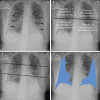Chest Radiograph Scoring Alone or Combined with Other Risk Scores for Predicting Outcomes in COVID-19
- PMID: 34519573
- PMCID: PMC8475750
- DOI: 10.1148/radiol.2021210986
Chest Radiograph Scoring Alone or Combined with Other Risk Scores for Predicting Outcomes in COVID-19
Erratum in
-
Chest Radiograph Scoring Alone or Combined with Other Risk Scores for Predicting Outcomes in COVID-19: A UK Study.Radiology. 2021 Dec;301(3):E444. doi: 10.1148/radiol.2021219021. Radiology. 2021. PMID: 34807774 Free PMC article. No abstract available.
-
Chest Radiograph Scoring Alone or Combined with Other Risk Scores for Predicting Outcomes in COVID-19.Radiology. 2022 Feb;302(2):E11. doi: 10.1148/radiol.219029. Radiology. 2022. PMID: 35073202 Free PMC article. No abstract available.
Abstract
Background Radiographic severity may help predict patient deterioration and outcomes from COVID-19 pneumonia. Purpose To assess the reliability and reproducibility of three chest radiograph reporting systems (radiographic assessment of lung edema [RALE], Brixia, and percentage opacification) in patients with proven SARS-CoV-2 infection and examine the ability of these scores to predict adverse outcomes both alone and in conjunction with two clinical scoring systems, National Early Warning Score 2 (NEWS2) and International Severe Acute Respiratory and Emerging Infection Consortium: Coronavirus Clinical Characterization Consortium (ISARIC-4C) mortality. Materials and Methods This retrospective cohort study used routinely collected clinical data of patients with polymerase chain reaction-positive SARS-CoV-2 infection admitted to a single center from February 2020 through July 2020. Initial chest radiographs were scored for RALE, Brixia, and percentage opacification by one of three radiologists. Intra- and interreader agreement were assessed with intraclass correlation coefficients. The rate of admission to the intensive care unit (ICU) or death up to 60 days after scored chest radiograph was estimated. NEWS2 and ISARIC-4C mortality at hospital admission were calculated. Daily risk for admission to ICU or death was modeled with Cox proportional hazards models that incorporated the chest radiograph scores adjusted for NEWS2 or ISARIC-4C mortality. Results Admission chest radiographs of 50 patients (mean age, 74 years ± 16 [standard deviation]; 28 men) were scored by all three radiologists, with good interreader reliability for all scores, as follows: intraclass correlation coefficients were 0.87 for RALE (95% CI: 0.80, 0.92), 0.86 for Brixia (95% CI: 0.76, 0.92), and 0.72 for percentage opacification (95% CI: 0.48, 0.85). Of 751 patients with a chest radiograph, those with greater than 75% opacification had a median time to ICU admission or death of just 1-2 days. Among 628 patients for whom data were available (median age, 76 years [interquartile range, 61-84 years]; 344 men), opacification of 51%-75% increased risk for ICU admission or death by twofold (hazard ratio, 2.2; 95% CI: 1.6, 2.8), and opacification greater than 75% increased ICU risk by fourfold (hazard ratio, 4.0; 95% CI: 3.4, 4.7) compared with opacification of 0%-25%, when adjusted for NEWS2 score. Conclusion Brixia, radiographic assessment of lung edema, and percentage opacification scores all reliably helped predict adverse outcomes in SARS-CoV-2 infection. © RSNA, 2021 Online supplemental material is available for this article. See also the editorial by Little in this issue.
Conflict of interest statement
Figures




Comment in
-
Disease Severity Scoring for COVID-19: A Welcome Semiquantitative Role for Chest Radiography.Radiology. 2022 Feb;302(2):470-472. doi: 10.1148/radiol.2021212212. Epub 2021 Sep 14. Radiology. 2022. PMID: 34519581 Free PMC article. No abstract available.
References
Publication types
MeSH terms
Grants and funding
LinkOut - more resources
Full Text Sources
Medical
Miscellaneous

